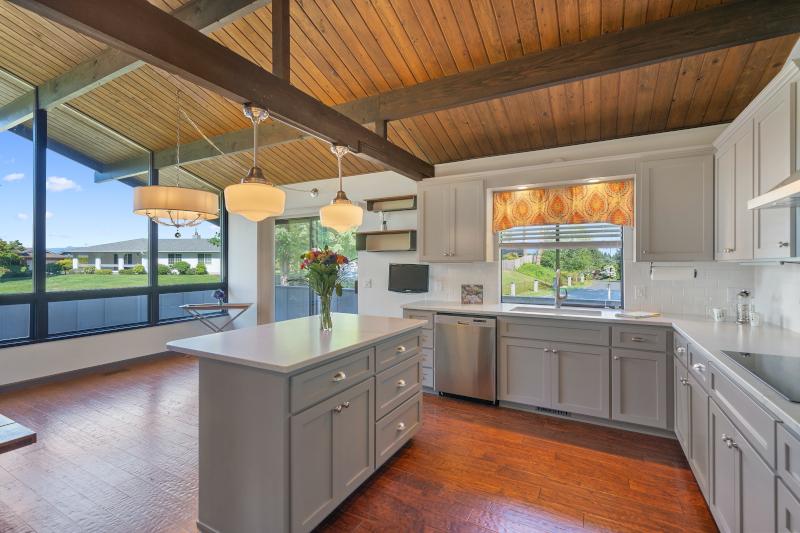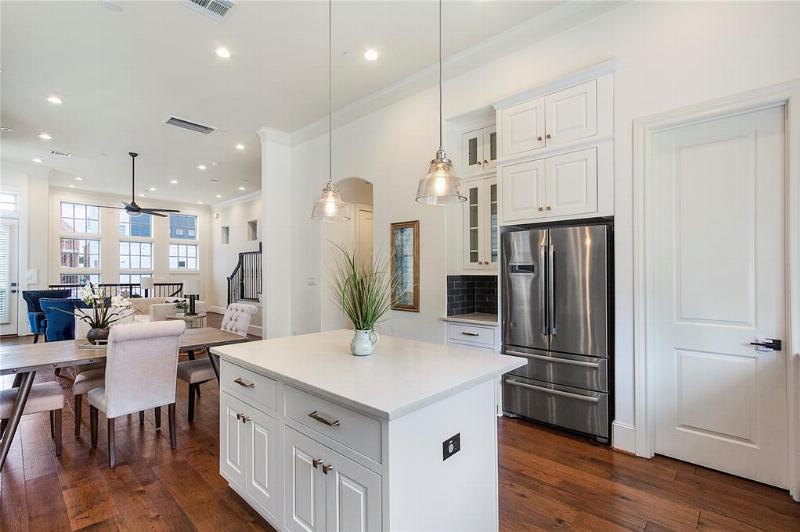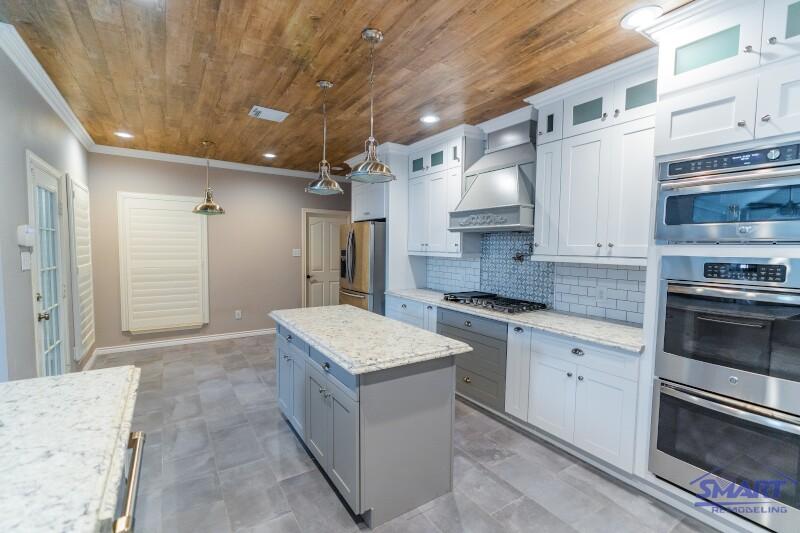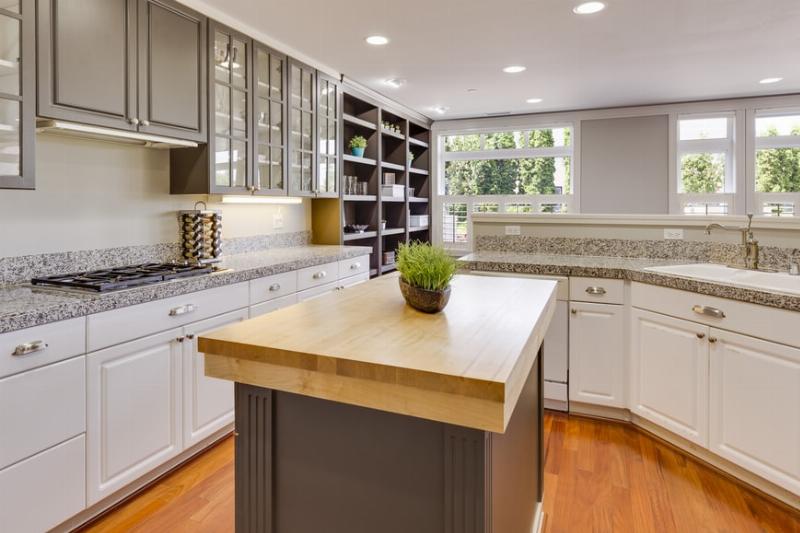How to Make a Kitchen Island Out of Base Cabinet
You can make a kitchen island out of a base cabinet. You may build a cheap island with base cabinets of various heights, types, and styles. Plan how you want your island to appear, and don’t allow traditions to hold you back.
Pro Tip Takeaway: Choose sturdy kitchen cabinets if you want to make a kitchen island out of base cabinets. Make sure they are made of strong materials like fiberwood or all wood. Don’t buy cabinets with cardboard backs because they won’t last long.
The kitchen island may make your kitchen more usable by accomplishing things like:
- Extra space for the things you need in the kitchen.
- More counter space or workspace that can be used as a place to prepare food.
- The cabinet space under the kitchen island can be used to store extra cooking tools and utensils. It’s also easy to get to all these things when you are cooking.
- It defines space in a home with an open floor plan or if your kitchen is open to your living room or dining room.
- It becomes the center of the kitchen since the kitchen is where everyone in the house gathers. If you love food and cooking, the kitchen island is a great place for you to work. With this layout, the host can cook food while facing guests or family members instead of the wall. That gives a lot more opportunities to talk to each other.
- You can have fun with your friends, cook live, or even do a vlog with a little music.
- The kitchen island can also be used as a place to eat.
Because it’s in the middle of the room and near the light, the kitchen island makes a great table. To make it a dining room, add chairs and make sure the countertop overhangs.
Things you will need
|
Base cabinets for the kitchen |
Bits for the drill and the screwdriver |
|---|---|
|
Wood glue |
Drill bits for pilot holes |
|
Clamps |
Screws for wood |
|
2×4 board that’s 8 feet long |
Tape measure |
|
Pencil |
Circular saw |
|
Trim-head screws for wood |
Butcher block slab for a counter |
|
Sandpaper with grits |
|
A cabinet-based island is hard to put together, but experts can do it. Custom layouts are needed for plumbing fixtures, electric appliances, and stone countertops. (This Old House 2011)
Built into the vast majority of kitchen islands will be at least one of the following features:
- Water
- Gas
- Electrical
Before any of this work begins, turn off all water lines, gas lines, and electric circuit breakers. This will keep everyone safe. If you don’t know what to do or aren’t sure, please call your utility company or a service professional.
Step 1
To Determine Kitchen Island Placement and Size
First, you want to leave enough space around your kitchen island so that you can walk around it.
42–48 inches of space should be left around a kitchen island. At least 42 inches of space should be available around a kitchen island. If the kitchen is big enough, 48 inches is better. If there isn’t at least 36 inches of space on all sides of the kitchen island, it shouldn’t be put in. If not, the island aisle way will be too small and make it hard to walk and do other things.
I know that most people’s dream is to have a big kitchen island, but not all kitchens can fit an island that big. That doesn’t mean, though, that you can’t have a kitchen island.
Standard kitchen base cabinets are 24 inches deep. You need 108 inches of space. width for a 42-inch pathway. Add 12 more inches if you want to add seating to one side. A total of 120 inches is needed within your kitchen. You may vary the length of your island by combining various sizes.
Pro tip takeaway: You need to fix your island in the place you choose to make it stable and safe.
Step 2
Connect the cabinets
Connect the cabinets back-to-back to get accurate floor cleat measurements.
Put the cabinets on something flat.
On the back of one cabinet, run a line of wood glue along the top, bottom, and side edges.
Align the sides and tops of the cabinets when you put them together.
Clamp the tops of the cabinets together.
Drill pilot holes and use wood screws about 3/4 inch below the top edges of the cabinets to hold them together.
Turn everything over. Align the sides, clamp the cabinets together, and screw them together 1 to 2 inches from the bottom. Let the glue dry for a full day.
Step 3
Attach the base cabinets
Attach the base cabinets to the 24 supports by screwing them together.
Find the length of the cleats by measuring the width of each cabinet’s base.
Using a circular saw or miter saw, cut two pieces of 2×4 lumber to the right length to make cleats.
Find out how thick the cabinet side walls and toe kicks are.
Place the island base (cabinet assembly) right-side-up on the kitchen floor. Use a pencil to mark the four corners of the island on the floor. Get rid of the island.
Using the thickness of the side and toe-kick, measure in from the lines you drew and mark the floor.
Place each cleat on the lines that have been drawn.
Drill pilot holes and use wood screws to attach cleats to the floor.
Pro tip takeaway: The style of the project will depend on the baseboard you choose. You can pick something daring or something easy. Even a board that is 1/2 inch thick, 3-1/2 inches tall, and has a very smooth top edge is fine. Choose baseboards that are between 3-1/4 and 4-1/4 inches tall.
Step 4
Create an island foundation
Set the island over the cleats and secure it with trim-head screws.
Place the island over the two cleats so that the cabinets are at the same level as the floor.
Check that each corner of the island is on the original lines you drew.
Drill pilot holes and use trim-head screws to attach each cabinet’s toe-kick to the cleat behind it. Drive the screws into the wood below the surface.
Step 5
Get the counter ready
You get to choose how much the countertop will hang over the edge. Keep in mind that an overhang is both for looks and function and that it doesn’t have to be the same on all sides. You can test overhang depths with a scrap of countertop or the blank before it’s cut.
Measure the top of the island’s base and add the length and width of the overhang you want for the countertop.
Using a circular saw, cut the countertop to the size you want.
Sand the cut edge to get rid of any saw marks and make the edges and corners as smooth and rounded as you want. Start with coarse sandpaper and use finer grits as needed to get smooth.
Attach a straightedge or board to the countertop to guide the circular saw’s base. This helps make sure the cut is straight and keeps the cut edge from splitting. (Hunker 2021)
Step 6
Put the countertop in place
Your kitchen island countertop choice depends on your tastes, budget, and usage. Here are some of the most common types of countertops you can choose from:
Granite is a popular material. It is known for being strong and able to keep moisture out, but it is expensive.
Butcher block countertops look nice, but they need a lot of care and attention.
Quartz countertops are more durable than granite countertops. Quartz is harder than granite. But, too much heat from cooking pans can damage it.
Wood countertops are screwed to cabinets, not glued. Make sure to use screws that are the right length. They should go far enough into the wood to hold, but not so far that they could poke through the countertop. On cabinet corners and edges. The wood blocks or plastic fittings hold the countertop in place with screws.
Measure from the island’s countertop edges to the cabinet faces to ensure parallelism. Drill holes for the screws from inside the base cabinets. Drive wood screws into the countertop after drilling pilot holes.
Are you ready to remodel your kitchen island?
This post shows how to turn a base cabinet into a kitchen island. Since we cook all the time, the kitchen is the center of every home.
Smart Remodeling LLC is a must if you want to improve the look of your kitchen. Book a free consultation right away. Call 832-808-8889 or write to sales@smartremodelingllc.com. Smart Remodeling LLC has the best kitchen island experts in all of Houston.









